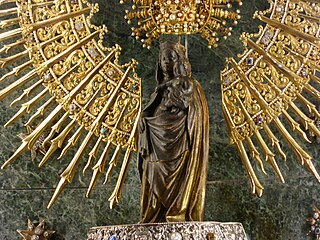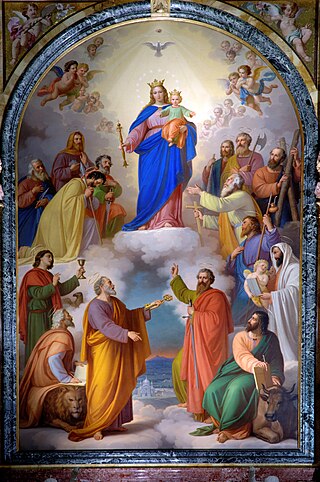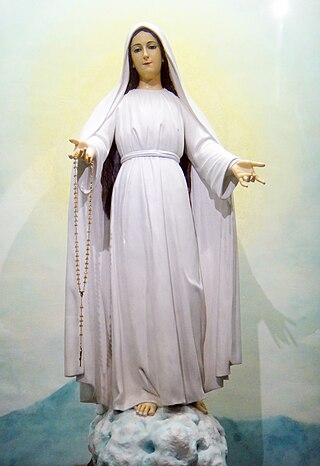
The First Saturdays Devotion, also called the Act of Reparation to the Immaculate Heart of the Blessed Virgin Mary, is a Catholic devotion which, according to Sister Lúcia of Fátima, was requested by the Virgin Mary in an apparition at Pontevedra, Spain, in December 1925.

The Litany of the Blessed Virgin Mary is a Marian litany originally approved in 1587 by Pope Sixtus V. It is also known as the Litany of Loreto, after its first-known place of origin, the Shrine of Our Lady of Loreto (Italy), where its usage was recorded as early as 1558.

Our Lady of the Pillar is the name given to the Blessed Virgin Mary in the context of the traditional belief that Mary, while living in Jerusalem, supernaturally appeared to the Apostle James the Greater in AD 40 while he was preaching in what is now Spain. Those who adhere to this belief consider this appearance to be the only recorded instance of Mary exhibiting the mystical phenomenon of bilocation. Among Catholics, it is also considered the first Marian apparition, and unique because it happened while Mary was still living on Earth.

The Pontevedra apparitions are the Marian apparition of Mary, mother of Jesus and her child, Jesus, that Sister Lúcia, the Portuguese seer of Our Lady of Fátima, reported receiving in December 1925, while living in a Dorothean convent in Pontevedra, Spain, and a visitation of the child Jesus by himself in February 1926, near the convent's garden.

Flores de Mayo is a festival held in the Philippines in the month of May. It is one of the May devotions to the Blessed Virgin Mary and lasts for the entire month.

Mary, the mother of Jesus in Christianity, is known by many different titles, epithets, invocations, and several names associated with places.

May devotions to the Blessed Virgin Mary refer to special Marian devotions held in the Catholic Church during the month of May honoring Mary, mother of God, as "the Queen of May". These services may take place inside or outside. A "May Crowning" is a traditional Roman Catholic ritual that occurs in the month of May.

The Mariology of the popes is the theological study of the influence that the popes have had on the development, formulation and transformation of the Roman Catholic Church's doctrines and devotions relating to the Blessed Virgin Mary.

The veneration of Mary in the Catholic Church encompasses various devotions which include prayer, pious acts, visual arts, poetry, and music devoted to her. Popes have encouraged it, while also taking steps to reform some manifestations of it. The Holy See has insisted on the importance of distinguishing "true from false devotion, and authentic doctrine from its deformations by excess or defect". There are significantly more titles, feasts, and venerative Marian practices among Roman Catholics than in other Western Christian traditions. The term hyperdulia indicates the special veneration due to Mary, greater than the ordinary dulia for other saints, but utterly unlike the latria due only to God.

Mary, the Help of Christians is a Catholic title of the Blessed Virgin Mary, based on a devotion now associated with a feast day of the General Roman Calendar on 24 May.

The Lady of All Nations is a Catholic Marian title sometimes associated with apparitions of the Blessed Virgin Mary to Ida Peerdeman of Amsterdam, Netherlands. Peerdeman claimed to have received 56 visions of the Lady from 1945 to 1959.

Within Catholicism, a miracle of the roses is a miracle in which roses manifest an activity of God or of a saint. Such a miracle is presented in various hagiographies and legends in different forms, and it occurs in connection with diverse individuals such as Saints Elizabeth of Hungary (1207–1231), Elizabeth of Portugal (1271–1336), Saint Dorothy, a 4th-century virgin martyr at Caesarea in Cappadocia, and Our Lady of Guadalupe.

Mary, the Mediatrix of All Grace, also known as the Our Lady of Lipa, is an alleged Marian apparition that occurred within the Carmelite Monastery of Lipa, Batangas, Philippines. The event occurred to a former Carmelite postulant, Teresita Castillo. The original statue associated with the apparition is currently enshrined at the monastery.
Betania is a small village in the parish of Cúa, Venezuela. It is popularly known for the shrine of Our Lady of Betania, where retired Catholic Bishop Pio Bello Ricardo declared authentic a Eucharistic Miracle that occurred there.
Mystic Rose or The Mystic Rose may refer to:

Pierina Gilli, was an Italian visionary who claimed to receive apparitions and messages from the Virgin Mary in 1947 and 1966. The Marian apparitions were originally determined by the local ordinary, after consultation with the Congregation for the Doctrine of the Faith (CDF), to be lacking in sufficient evidence of credibility. However, a process of review which began in 2013 and is ongoing as of 2022 has reached a provisional finding of the 'validity and exemplarity of the mystical-spiritual experience of Pierina, as well as the richness of her existential, humble and virtuous story.' Having reached a favourable view of the person of the visionary, the diocese is conducting a review of the theology of Pierina's writings in the light of Catholic teaching.
Emma C. de Guzman is a Filipino Roman Catholic widow, laywoman, stigmatist and claimed Marian visionary. She is the co-founder, along with the late Sister Soledad Gaviola, of the Catholic lay group association La Pieta, dedicated to a Marian devotion under the title Mother of Love, Peace and Joy. Guzman claims to have first seen the Virgin Mary on the Feast of the Nativity of Mary in 1991.

Mary Cecilia of Jesus, OCD, born as Natividad Zialcita, was a Discalced Carmelite nun and prioress of the monastery in Lipa during the time apparitions of Our Lady Mediatrix of All Graces in 1948. She was also the confidante of the visionary postulant, Teresita Castillo.

Our Lady of the Rosary of San Nicolás is, in Catholicism, a title of veneration of the Blessed Virgin Mary associated with a reported private revelation to Gladys Quiroga de Motta, a middle-aged housewife, beginning in the 1980s in the city of San Nicolás de los Arroyos, Argentina. Quiroga said that she was tasked with promoting devotion to the Mother of God under this title, with an emphasis on key passages in the Bible and a particular mystical stellar symbolism.
















